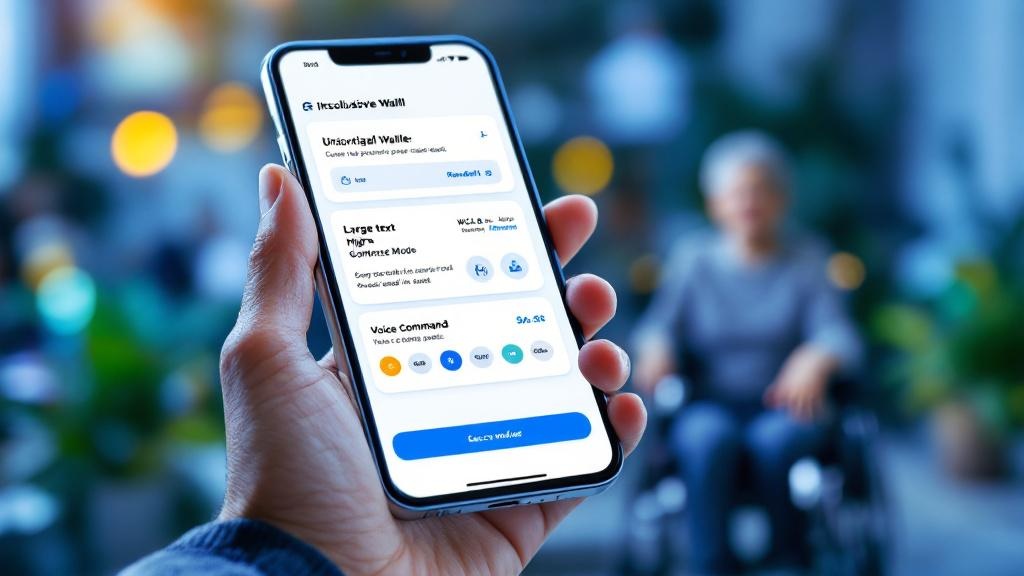Introduction: Why Digital Wallet Accessibility Matters
Digital wallets have revolutionized how we pay, save, and manage money. But as this technology becomes mainstream, an essential question arises—is it truly accessible to everyone?
Today, millions of users with disabilities rely on accessible digital wallets for day-to-day transactions. From screen reader compatibility to voice-enabled payments, mobile wallet accessibility features are no longer optional—they’re a necessity.
This article explores digital wallet accessibility, why it matters, and how fintech companies can create inclusive digital payment systems that work for everyone, including disabled users.
What Is Digital Wallet Accessibility?
Digital wallet accessibility refers to the ability of all users—including those with visual, auditory, motor, or cognitive impairments—to easily use and interact with digital wallets and mobile payment apps.
Key Components Include:
Screen reader compatibility (for visually impaired users)
Voice commands and feedback
Keyboard and switch device navigation
Color contrast and text size adjustments
Touch-free payment options
When apps are designed with universal design principles and accessibility compliance in mind (like WCAG or ADA standards), they create equal opportunities for digital financial participation.
Why Accessibility in Fintech Apps Is Crucial
Let’s break down why accessibility in fintech apps is more than just good practice—it’s a moral, legal, and business imperative.
1. 1 Billion+ People Worldwide Live With a Disability
According to the WHO, over 1 billion people experience some form of disability. That’s nearly 15% of the global population—and many use digital financial tools.
2. Legal Requirements Are Expanding
In countries like the U.S., U.K., and parts of the EU, accessibility compliance is mandated. Failure to comply with ADA or WCAG guidelines can result in lawsuits, reputational damage, and loss of customer trust.
3. Inclusive Products Increase User Adoption
Apps that are easier to use by everyone—regardless of ability—see higher engagement and customer loyalty. Accessibility fuels inclusion, which drives growth.
Features That Make Digital Wallets Accessible
Designing a digital wallet for disabled users doesn’t require a complete overhaul—just smart, thoughtful features.
🔊 Screen Reader Compatible Wallets
Text-to-speech support for navigation and confirmation
Descriptive labels for buttons, icons, and fields
Clear focus indicators for keyboard users
Example: Apple Pay’s VoiceOver integration makes wallet functions accessible to blind users.
🗣️ Voice-Enabled Payment Apps
Voice commands to send, receive, or request money
Voice feedback confirming transactions or balances
Google Pay allows some voice functionality via Google Assistant, improving accessibility for users with mobility impairments.
🧠 Simplified, Cognitive-Friendly UI
Logical layout with clear call-to-action buttons
Use of plain language, minimal distractions
Option to toggle simplified view or larger text
PayPal’s recent UI update emphasizes readability and visual clarity.
🧍 Touch-Free Payment Options
NFC-based tap-to-pay
QR code scanning
Gesture-based interactions
Apps like Samsung Wallet support touch-free transactions, ideal for users with motor impairments.
🧩 Customizable Accessibility Features
Font size, contrast modes, haptic feedback
Accessibility shortcuts
Support for assistive technologies like Braille displays
Best Practices: Designing Inclusive Digital Wallets
Whether you’re building from scratch or improving an existing app, here’s how to apply accessible UI/UX design principles:
H2: 1. Follow Accessibility Compliance Standards
Use WCAG 2.2 and local laws like ADA or EN 301 549 as your baseline. Aim for Level AA compliance or higher.
H2: 2. Include Disabled Users in User Testing
Involve real users with disabilities during beta testing. Use their feedback to refine digital wallet user experience and ensure accessibility across real-world scenarios.
H2: 3. Prioritize Mobile App Accessibility Standards
Since most wallets are mobile-first, design for:
Screen magnifiers
Dynamic type sizing
OS-level accessibility settings
Color-blind-friendly themes
H2: 4. Use Universal Design in Fintech
Universal design benefits everyone. A simpler, cleaner UI that works well with one hand, supports screen readers, and offers text clarity is good UX for all users.
Real-Life Example: Inclusive Digital Payment System in Action
Case Study: PhonePe’s Accessibility Overhaul (India)
PhonePe, one of India’s largest digital wallets, worked with visually impaired users to add screen reader compatibility, voice feedback, and high-contrast modes. Within 6 months:
App usage among visually impaired users grew by 37%
Complaint rates dropped by 60%
The app earned praise from disability rights advocates
Lesson: Inclusion is innovation. Investing in accessibility pays off.
Benefits of Accessibility for Fintech Brands
✅ Broader Customer Reach
More users can adopt your product, including seniors, people with disabilities, and others with temporary limitations (like injuries or language barriers).
✅ Better SEO and App Store Visibility
Accessibility improvements often improve performance, content structure, and app discoverability.
✅ Increased Trust and Loyalty
Users feel valued when their needs are respected. This builds brand trust and long-term loyalty.
Challenges in Implementing Accessibility (And How to Overcome Them)
❌ Lack of Awareness
Many developers are unaware of what digital inclusion involves. Solution: Offer training on mobile app accessibility standards.
❌ Legacy Systems
Older platforms may not support newer accessibility tools. Solution: Incrementally update with modular improvements.
❌ Perceived High Costs
Designing accessible interfaces can seem expensive. Solution: Use open-source accessibility toolkits and prioritize based on user impact.
FAQs About Digital Wallet Accessibility
1. What is digital wallet accessibility?
Digital wallet accessibility ensures mobile payment apps can be used by everyone, including users with disabilities. It involves features like screen reader support, voice commands, and customizable UI elements.
2. Which mobile wallet apps are best for visually impaired users?
Apps like Apple Pay, PhonePe, and Google Pay offer excellent screen reader compatibility and support for voice-enabled payment features.
3. What are assistive technologies used in digital wallets?
These include screen readers, Braille displays, voice assistants, haptic feedback, and gesture controls that help users with disabilities navigate wallet apps.
4. Are there regulations for fintech accessibility?
Yes. The ADA (Americans with Disabilities Act), WCAG guidelines, and various country-specific laws require apps to be accessible.
5. How can fintech companies implement accessibility quickly?
Start with user feedback, audit your app using accessibility testing tools, and follow universal design principles. Prioritize the highest-impact changes first.
6. What is universal design in fintech?
It’s the practice of building interfaces that are usable by everyone, regardless of ability or disability. It’s the cornerstone of inclusive digital payment systems.
7. Can accessibility increase app store ratings?
Yes. Apps that are easier to use by everyone often receive higher reviews and ratings, improving visibility in search results and app store rankings.
Conclusion: Building a Fintech Future That Includes Everyone
Digital wallet accessibility isn’t a luxury—it’s a requirement for a fair and inclusive financial system. From screen reader compatible wallets to touch-free payment and voice-enabled interfaces, every step toward inclusive digital payment systems makes a difference.
Fintech is for everyone. Let’s design it that way.








Comments (0)